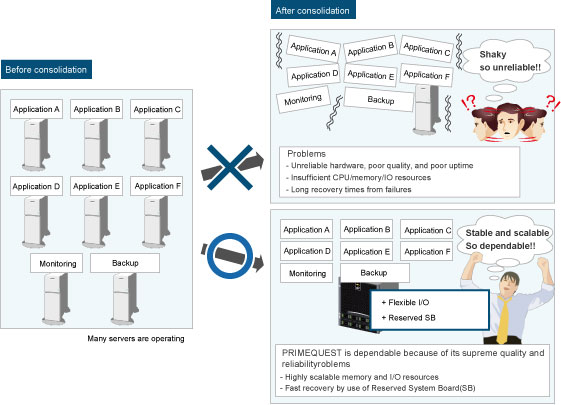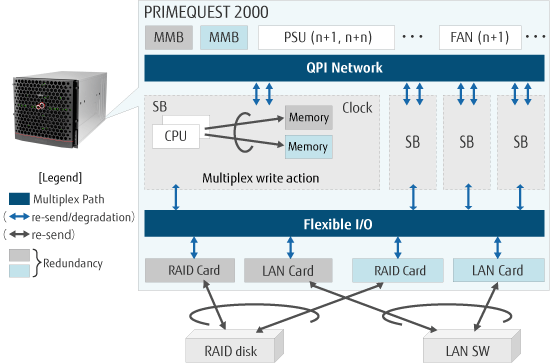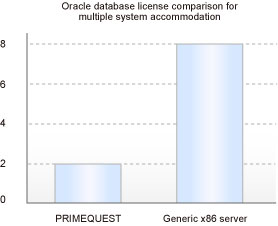Archived content
NOTE: this is an archived page and the content is likely to be out of date.
The Best Platform for Consolidating Mission Critical Applications
To keep up with changes in their business environment, many companies around the world are constructing next-generation IT infrastructures. Key technologies in being successful with this involve server consolidation and virtualization.
Such advances in technology are encouraging companies to use virtualization to consolidate mission-critical systems. However, there are concerns that a failure in one virtual machine may cause problems for the entire physical environment. It is therefore very important that the virtualization of mission critical systems includes the highest levels of reliability and availability.
Background
The more you consolidate servers, the higher the risks and costs of avoiding failure
With management focus on cost reduction, strengthening the business in a changing environment requires smart use of IT infrastructure.
The market trend to server consolidation is now moving and expanding into database and other mission critical system use. The increased use of server resources has the appealing benefit of TCO reduction. However, the risk of major system downtime lurks beneath the obvious benefits and may negate any savings by introducing the potential for lost business.
In planning server consolidation, the IT department must consider both business efficiency and system availability in the resulting consolidated system – the ideal is the systems can't be interrupted and the TCO reductions remain.
The following sections outline the major challenges in business continuity and server consolidation.
The Challenges
The Problems of Dense Server Consolidation
Challenge #1: Higher reliability is required for consolidated servers
One server failure has the potential to stop all applications running on the consolidated server. So, in addressing server consolidation it is essential to look for high-reliability platforms.
 Figure 1. Server consolidation and its platform reliability
Figure 1. Server consolidation and its platform reliability
Challenge #2: Performance overhead
With generic x86 servers, server consolidation requires OS with virtualization features. "Bill" for such virtualization includes CPU and memory for performance overhead. So, you should look at such performance overhead closely before starting a project. If the performance is not sufficient, you must abandon the project.
Performance overhead is an amount of system resources that OS consumes for virtualization. If a software product is charged per CPU, the costs are included in your payment. (*1)
*1For the detail, refer to "Performance Results" of "Virtualizing Performance-Critical Database Applications in VMware vSphere 6.0".
http://www.vmware.com/files/pdf/products/vsphere/vmware-database-apps-perf-vsphere6.pdf
Challenge #3: ISV products charged beyond "partition"
You need to pay full care of ISV products' license policy before you start a virtualized system project. If the relevant ISV product is charges to CPU core, the charge may be higher than your expectation.
For instance, Oracle Database on virtualization OS charges to all the CPU core in the server or relevant "Hardware Partition". *2 However, Oracle does not categorize virtual machine in virtualization OS to "Hardware Partition". So, for generic x86 server which does not have hardware partitioning, all the cores in a server are charged for Oracle Database.
*2For the detail of Oracle Corporation's policy for Oracle Database charge, please refer to "Hard Partition" of "Partition" below.
http://www.oracle.com/us/corporate/pricing/partitioning-070609.pdf
Challenge #4: Limited availability for ISV products
You also need to pay full attentions to ISV products availability on virtualization OS. Undeniably, an ISV may be more reluctant for supporting a virtualization OS than a non-virtual server platform. Database server is not an exception. If you are going to accommodate Oracle Database server on a virtualization OS, you will find out your selection of OS is very limited.
Point
PRIMEQUEST is the best platform for consolidation of mission critical applications. PRIMEQUEST allows improvement for business continuity for dense consolidation projects with minimal cost addition.
Solutions
Install the mission-critical IA server "PRIMEQUEST" as the platform for server consolidation. With its high reliability and quick recovery from errors, it allows users to enjoy Mainframe-class high reliability and availability.
PRIMEQUEST can maximize reliability by earliest possible error detection and correction for CPU and memory by fully redundant components and concurrent maintenance. Plus, hardware partitioning can isolate hardware errors and can help recover failed System Board automatically.
Capable up to 80 cores along with large memory and abundance of I/O resources, high-performance can be achieved even in the most dense virtualization environments.
Business Benefits
Business Benefits #1: The highest reliability and fast recovery
Even after a system failure, PRIMEQUEST can maximize uptime by full redundancy and hardware partitioning.
As you see in a diagram below, almost all the components are redundant.
- The following components can be redundant or multiplex.
Memory, PSU, Fans, PCI Cards, and MMB
Transmission from/to the components below can be multiplex - QPI network and PCI Express switch
Isolating a failed partition from other systems, PRIMEQUEST hardware partitioning can maximize uptime – no hardware or firmware failure affect on other partitions.

Business Benefits #2: No pain for performance overhead
Hardware partitioning of PRIMEQUEST never sacrifices performance. Its system integration is simple because of no need to measure performance overhead caused by virtualization.
You can consolidate servers without paying for virtualization OS and system resources.
Business Benefits #3: ISV product license limited to Hardware Partition
Regardless of ISV products license charge policy or OS underneath, PRIMEQUEST can limit their licenses to the hardware partition ISV products are installed. If you are going to use Oracle database with one generic x86 server, it charges to all the cores in the server.
Such extra payment is unavoidable even if you are installing Oracle database and applications in one server and you partition them by popular virtualization products such as Red Hat Enterprise KVM, Xen or VMware vSphere.
PRIMEQUEST can reduce Oracle database fee regardless of OS installed in the hardware partition


Business Benefits #4: Rich ISV products available
With PRIMEQUEST, you do not need to examine ISV products availability on a virtualization OS because all the ISV products support Red Hat Enterprise Linux or Windows for x86 can automatically support PRIMEQUEST.
On the other hand, if you are going to use virtualization OS in your platform, you need to confirm support status as follows.
- Support status of relevant ISV product on the virtualization OS
- Virtualization OS's support status for relevant ISV product
Such cross-check is necessary because you cannot exclude the possibility for discrepancy between ISV and virtualization OS vender.



 01235 797711
01235 797711